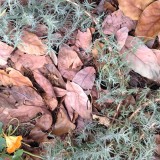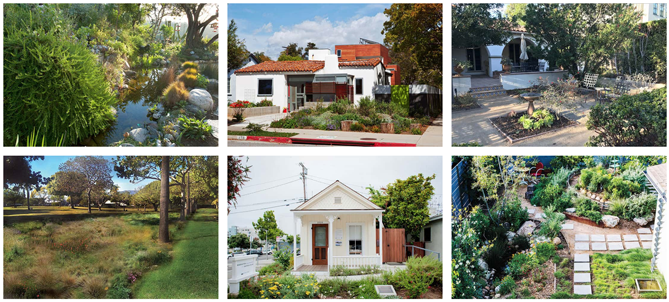One of the new features of the garden this year is a long, trough-shaped bed that Erik installed along the edge of our patio. Its inaugural crop was garlic, which is generally a very easy plant to grow. We’ve done it before, many times, successfully. This year it didn’t work. The stalks failed to thrive. Many plants did not set bulbs at all, looking instead like green onions. The heads that were formed are quite small.
We’re not sure why this happened. All spring Erik scoured books trying to find an obvious solution, but couldn’t make any clear diagnosis. Our winter/spring weather was strange: torrential rains and cold interspersed with heat waves. Our best guess is that this irregularity created conditions ripe for various sorts of molds and bacteria which garlic does not get along with. Another possibility is that the soil in this bed, which was transferred from another bed, may have pre-existing problems. C’est la vie, as we say around the compost heap. We’ll be buying garlic this year.
We may send the soil in this bed off for testing, or just plant a legume cover crop in it for the summer, and decide what to do with it in the fall.
 |
| The bed newly constructed and planted. Alas, those were hopeful days… |
 |
| It started off good, but just sort of declined steadily. |
The original post about the garlic trough here.







I’m in N. Oakland subject to similar weather conditions. Our garlic turned out really well, big bulbs and pretty strong stalks, so I don’t think it’s the weather. Maybe we planted at different times? I think we might have stared planting in Jan/Feb though I could be off.
I just don’t know :/
If you haven’t been rotating your crop you may have allowed a nematode (Ditylenchus dipsacci)to build up in your patch…Cheers!
@Girl: We planted ours earlier, like in Nov. I think–that could make a difference
@Bear: It’s not nemotodes–we checked for that. Good guess, though.
I hate it when a crop utterly fails and you have no idea why. Your guess with the weather might be a good one, but I’d still ship off a sample to see if something more sinister is at work. It would be a shame to lose another year’s investment of water, seed, time, and the ultimate factor for backyard farming: space!
The only thing I can think of that may have happened was the soil ph is too high. Sometimes that happens if you plant too close to concrete or where there was a patch of concrete. Compounds in the concrete leach into the soil and the ph goes too high. I’m not sure what happened garlic is normally such a hardy plant…It’s so sad the bed looks great but they are just not happy 🙁
I’m not sure here, but from what I have read in the past garlic that you buy from stores and some less than scrupulous sellers should not be planted because they have not been tested for a certain virus that affects them. The rumor is that once you have introduced the virus into your raised bed you cannot get rid of it, and it will affect subsequent crops.
I have only done half-research on this though so you might want to check it out.
http://www.fitopatoatlas.org.ar/images/soporte_digital/3998_Rendimiento_GarV-C_A.pdf
@Paula: Yeah, we’ll probably test it.
@Desert: Now that’s an intriguing theory!
@Celt: Good tip. This was quality seed garlic, so I hope that was not the problem.
I wondered too if it had something to do the sordid past of the concrete, although I was thinking more along the lines of hard packed clay underneath the raised bed. I have a long bed of garlic planted last fall (in SW VA), and in the middle of it we hit rock. DH very stubbornly hacked out about 6-8″ of rock but still, that section of garlic looks about like yours. The rest is not fabulous, but much better than the stuff with a shallow depth of soil.
I’ve had surprising garlic problems this year too. I understand some of it I think, but some is a bit of a mystery. We should compare (mental) notes sometime.
Could it be a drainage problem and they are being slowly suffocated? I have read that raised beds are more like pots than in ground plantings, maybe the transferred soil lost too many of its air pockets.
it sounds exactly like the mysterious fate of my garlic this year! i am growing in new orleans and new to this southern locale and i was thinking maybe i had been supposed to look at day length like onions. they grew gorgeously all through the fall and early spring, and i was so excited because some of the stalks were so fat and i thought i was going to have a killer harvest. they started yellowing off around april, and i thought, oh boy, they’re ready! but no bulbs. a few had tiny half formed bulbs, but mostly not. i let them go quite awhile thinking maybe they would form the heads as they died back. but no dice. ended up scraping the rotten outer layers off of my whole crop and using it as “green garlic” such a bummer.
btw, i got your new book and it’s great. i wish i had read the soap/laundry detergent section a year ago, before i had to figure all that stuff out on my own. now tell me why my liquid laundry soap made from coconut oil soap solidifies? is it because coconut oil itself is a solid? what do i do about it? it’s annoying to have to scoop out your “liquid” soap and run the washer on hot to dissolve it. that’s why i made liquid instead of just the powder, so i could run it on cold.
now i’m into summer again, when coconut oil is a liquid. my last batch stayed liquid. is it coincidence?
I had a similar problem last year when the winter was just cold and wet – they succumbed really badly to rust and when pulled out were just puny and not worth it. I left most of them in. This year when the ones that were viable started growing, i split them up. They’re currently almost ready to harvest, and are the hardiest garlics to make it through! I can’t recall which varieties they were though…. 😛
If you guys wanna try again, I got my garlics from gourmet garlics. Huge selection! I went with a sampler pack appropriate for our region. Very lovely garlics.
@ De: Could be!
@Scott: Nice to know even the pros are stumped sometimes. We’ll definitely exchange notes
@Ginny: That sounds on-track, just in terms of my gut feeling about the whole thing.
@Apron: Homemade liquid soap is difficult–that’s why I chickened out and opted for the dry recipe in the book. It re-solidifies randomly–depending a lot on the type of soap, but also other factors to numerous to track. Mostly folks water it down tons to avoid this–but then you have homeopathic laundry soap! I’m sorry I can’t answer your specific question.
I’ve found that my homemade coconut oil soap doesn’t tend to solidify. Of late I’ve been using soap nuts more than anything. Or sometimes I revert back to just using a squirt of Dr. Bronner’s and a scoop of baking soda. There’s so many ways to do laundry! Sorry I can’t be of more help.
Same thing happened to me this year. Garlic in raised beds, never planted garlic there before, quality seed bulbs, planted in November – and now the foliage is starting to die back and I have pathetic little bulbs or no bulb to speak of at all.
I am very interested if you figure it out. I hate it when I put so much effort (and money) into something and it is an utter failure.
I’m not sure if you have different strains of garlic for your climate. But our garlic needs 30 consecutive days minimum (up to 60 for some strains) at 0-10 degrees Celsius for the bulb to form into cloves. If your heat wave hit in the middle of this period you only get a whole bulb
Alys
@Anon: Now, that’s interesting!